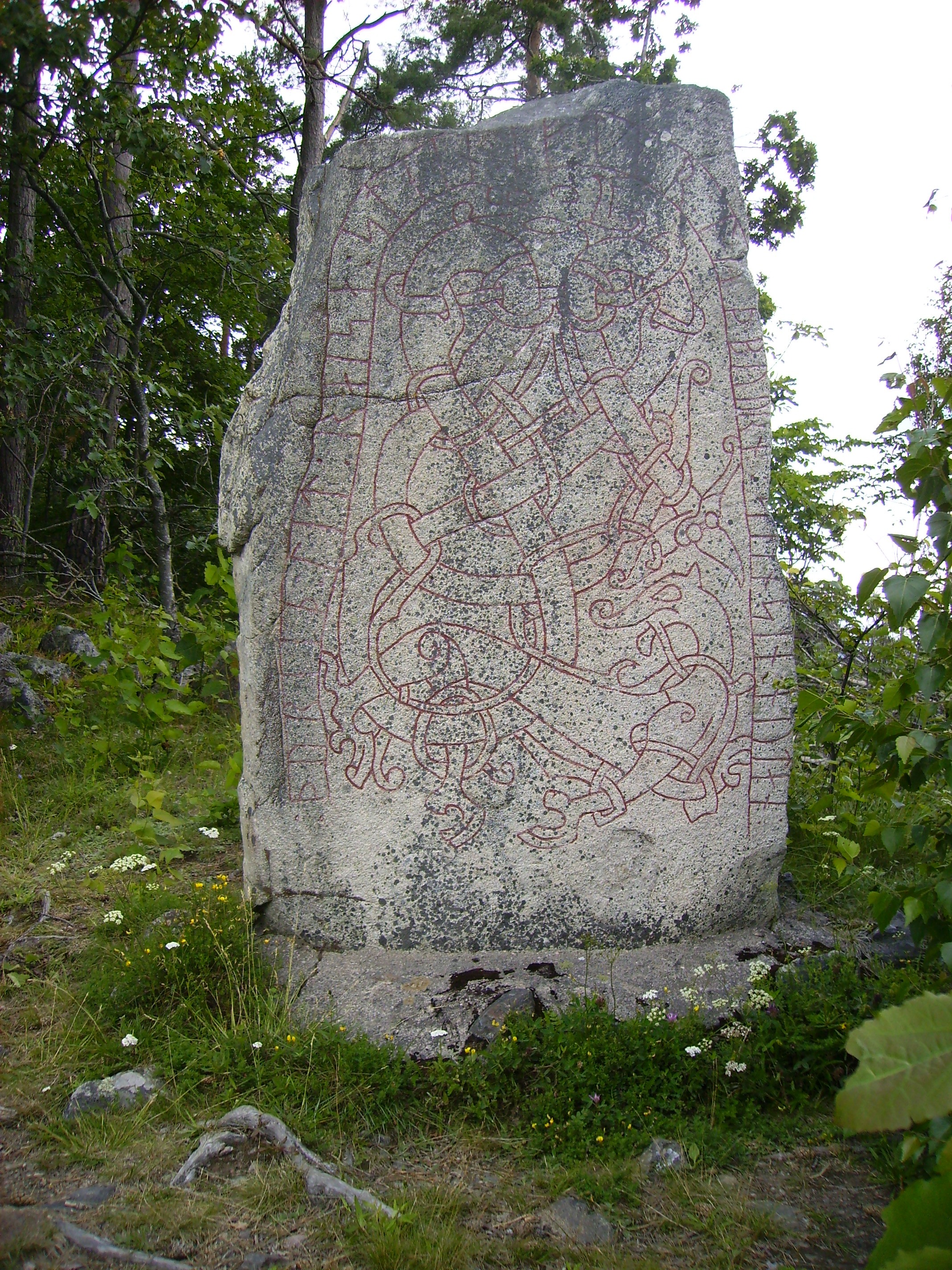Nasta Runestone on:
[Wikipedia]
[Google]
[Amazon]
 The Nasta Runestone, listed as Nä 34 in the
The Nasta Runestone, listed as Nä 34 in the
-
Photograph in 1995
-
Rundata
The Scandinavian Runic-text Data Base ( sv, Samnordisk runtextdatabas) is a project involving the creation and maintenance of a database of runic inscriptions. The project's goal is to comprehensively catalog runestones in a machine-readable way f ...
catalog, is a Viking Age memorial
A memorial is an object or place which serves as a focus for the memory or the commemoration of something, usually an influential, deceased person or a historical, tragic event. Popular forms of memorials include landmark objects or works of a ...
runestone located in Nasta, which is 3 kilometers northwest of Glanshammar, √Ėrebro County, Sweden
Sweden, formally the Kingdom of Sweden,The United Nations Group of Experts on Geographical Names states that the country's formal name is the Kingdom of SwedenUNGEGN World Geographical Names, Sweden./ref> is a Nordic country located on ...
, which was in the historic province of Närke.
Description
The inscription on Nä 34 consists of runic text in the younger futhark within a runic text band that arches around the edge of the stone, and a depiction of a beast and an intertwined serpent and a facial mask. The inscription on this granite stone, which is 2.25 meters in height, is classified as perhaps being carved in runestone style Pr3, which is also known as Urnes style. This is the classification for runic bands with beast or serpent heads depicted in profile with almond shaped eyes. The question regarding the proper classification for Nä 34 is that the runic text band has no attached beast or serpent heads, but the depiction of the serpent and beast depicted have some characteristics typical of the Urnes style. The facial mask on this stone, which is just under the arch of the text band, is a commonmotif
Motif may refer to:
General concepts
* Motif (chess composition), an element of a move in the consideration of its purpose
* Motif (folkloristics), a recurring element that creates recognizable patterns in folklore and folk-art traditions
* Moti ...
and is found on several other Scandinavian runestones including DR 62 in Sjelle, DR 66 in Århus, DR 81 in Skjern, DR 258 in Bösarp, the now-lost DR 286 in Hunnestad, DR 314 in Lund, DR 335 in Västra Strö, Vg 106 in Lassegården, Sö 86 in Åby ägor, Sö 112 in Kolunda, Sö 167 in Landshammar, Sö 367 in Släbro, U 508 in Gillberga, U 670 in Rölunda, U 678 in Skokloster, U 824 in Holms, U 1034 in Tensta, and U 1150 in Björklinge, and on the Sjellebro Stone. The stone was noted as being on a pile of rocks during the initial survey of Swedish runestones in the 1600s by Johannes Bureus. As it was near a main road, the stone was raised in 1672 by Johan Hadorph
Johan Hadorph (May 6, 1630 ‚Äď July 12, 1693) was a Swedish director-general of the Central Board of National Antiquities.
He was appointed National Antiquarian at the government agency for antiquities, and he became its director-general. Hadorp ...
for the Eriksgata of king Charles XI
Charles XI or Carl ( sv, Karl XI; ) was King of Sweden from 1660 until his death, in a period of Swedish history known as the Swedish Empire (1611‚Äď1721).
He was the only son of King Charles X Gustav of Sweden and Hedwig Eleonora of Holstein- ...
. It was noted that local people in the 1700s sometimes bit the stone as a cure for toothaches and left pins or nails on the stone as offerings for good crops. In 1952 the stone was moved six meters from the south side to the north side of the road.
The runic text states that the stone was raised as a memorial by a woman named √ě√≥rhei√įr for her son named Ly√įbj√īrn, who is described in Old Norse as being ''nytan'', which is a rare word that is translated as "capable" but may mean "bright and cheerful." The text is very worn and was somewhat damaged in the 1840s when a farmer attempted to "improve" the inscription.
The stone is known locally as the ''Nastastenen'' or, since it is the only runestone in the Rinkaby synod, as the ''Rinkabystenen''.
Inscription
Transliteration of the runes into Latin characters
:: √ĺurei√ĺ : lit : raisa : stein : eftir : ly√ĺbyurn : sun sin : nutan :Project Samnordisk Runtextdatabas Svensk-
Rundata
The Scandinavian Runic-text Data Base ( sv, Samnordisk runtextdatabas) is a project involving the creation and maintenance of a database of runic inscriptions. The project's goal is to comprehensively catalog runestones in a machine-readable way f ...
entry for Nä 34.
Transcription into Old Norse
:''√ěorh√¶i√įr let r√¶isa st√¶in √¶fti Ä Ly√įbiorn, sun sinn nytan.''Translation in English
:√ě√≥rhei√įr had the stone raised in memory of Ly√įbj√īrn, her capable son.References
External links
Photograph in 1995
-
Swedish National Heritage Board
The Swedish National Heritage Board ( sv, Riksantikvarie√§mbetet; RA√Ą) is a Swedish government agency responsible for World Heritage Sites and other national heritage monuments and historical environments. It is governed by the Ministry of Cult ...
{{coord, 59, 20, 25, N, 15, 21, 02, E, region:SE-T_type:landmark_source:kolossus-dewiki, display=title
Runestones in Närke